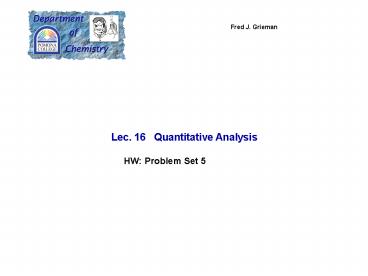Lec' 16 Quantitative Analysis - PowerPoint PPT Presentation
Title:
Lec' 16 Quantitative Analysis
Description:
5 Anions and 5 Reagents: 25 possible rxns (4 types NR) ... Hematite !!!! Next Time: Not rocks - GASES. Make pretty jewelry. for our significant others ... – PowerPoint PPT presentation
Number of Views:126
Avg rating:3.0/5.0
Title: Lec' 16 Quantitative Analysis
1
Fred J. Grieman
Lec. 16 Quantitative Analysis HW
Problem Set 5
2
5 Anions and 5 Reagents 25 possible rxns (4
types NR) Qualitative Analysis Reagents
Typical Reaction HNO3 Acid/Base,
Redox OH- Acid/Base Ba2 Precipitation
Co2 Complexation, Precipitation, Redox (Co3)
H2O2 (H) Redox, Acid/Base H2O2 Good
Reducing and Oxidizing Agent In Acid ? Oxidizing
Agent ½ reactions 2 e- 2 H H2O2 ? 2
H2O Oxidizing Agent
H2O2 ? O2 2 H 2 e- Reducing
Agent Can Disproportionate as well in
Acid Solution
Anions
3
Solution Stoichiometry A
MA Quantitative Analysis
VA
nA mA Precipitation Usually
measure mass of solid to determine mass (e.g.,
CaC2O4) Acid/Base, Redox, Complexation
Usually use Titration Titration analytical
method of adding measured volumes to determine
unknown concentration/amount of some
substance Buret for accurate volume measurement
Indicator to show end of reaction
Buret filled with titrant
Acid/Base Titrant Strong Base with Sample
Weak Acid Must know OH- Standardization
(with known Weak Acid) potassium hydrogen
phthalate KHC8H4O4 (KHP) M 204.2
g/mol KOH(s) used to make base titrant (very
difficult to measure mass) HC8H4O4? OH ? ?
C8H4O42? H2O at endpoint all HC8H4O4?
reacts, small excess OH- turns indicator
pink. Suppose 25.00 mL of (OH-) to reach
endpoint of 0.765 g KHP n(KHP) m(KHP)/M(KHP)
0.765 g / 204.2 g/mol(KHP) 3.75 x10-3
mol KOH n(OH-)/V(OH-) n(KHP)/V(OH-)
(3.75x10-3) / 0.02500L) 0.150 M
we can now use to determine Acid amounts
Sample with indicator to show endpoint
4
Example Environmental Chemist wants to know
amount of benzoic acid in
effluent in industrial process What mass
? Takes 0.350 g sample, dissolves it in
water Using buret with 0.150 M NaOH, neutralizes
(end of rxn.) with 10.60 mL Net ionic eq.
OH-(aq) C6H5CO2H(aq) ? H2O(l)
C6H5CO2-(aq) strong
base weak acid ? completion ???
n(OH-) n(C6H5CO2H) 11 Stoichiometry
n(OH-) OH- V(OH-) (0.150 M) (10.60
mL) (1L/1000mL)
1.59 x 10-3 mol n(C6H5CO2H)
m(C6H5CO2H) ??? n(C6H5CO2H) M(C6H5CO2H)
(1.59 x 10-3 mol)(122.125 g/mol)
0.194 g Mass m(C6H5CO2H)
/m(sample) x 100 0.194 g / 0.350 g x 100
55.5
Structure M 122.125 g/mol
weak acid
5
- Balancing Redox Reactions Half Rxn Method (12.1
in text) (My method below) - 7 3
4
4 - MnO4- C2O42- ? MnO2 CO32-
in acid - 1) Assign ox.s ? oxdzd rdcd species
- Write unbalanced ½ rxns. for oxdzd rdcd species
-
3 4 - C2O42- ?
CO32- - 7
4 - MnO4- ?
MnO2 - 3) Balance elements except O H
- 4) Add e- to balance ox. change
- 5) Multiply ½ rxns. by factors to balance e-s
- 3 C2O42- ? 6
CO32- 6 e- - 6 e- 2 MnO4- ? 2
MnO2
(
) 3
2
2 e-
(
) 2
3 e-
4
2
6 H2O
12 H
8 H
4 H2O
6
Fig. 17-17 Common Oxidation States
7
Find a rock. Want to know what it is (made of Fe
O only) Redox Titration !!! -
Grind up 1.04 g of rock Via reducing agent turn
all Fe into Fe2 in acid solution Use 0.100 M
MnO4- , a dark purple solution in buret Rxn.
MnO4- 5 Fe2 8 H ? Mn2 5 Fe3
4 H2O endpoint solution stays purple 26.00
mL of titrant to endpoint. ??? m(Fe) ???
Use 15 Stoichiometry n(MnO4-) V(MnO4-)
MnO4- (0.02600 L) (0.100) 2.6 x 10-3
mol n(Fe2) 5 mol(Fe2)/1 mol(MnO4-)
n(MnO4-) 5 (2.60 x 10-3 mol) 1.30 x 10-2
mol m(Fe) n(Fe2) M(Fe) (1.30 x 10-2 mol)
(55.847 g/mol) 0.726 g Mass(Fe) m(Fe) /
m(sample) x 100 69.8 If rest is O
m(O) 1.04 g 0.726 g 0.314 g n(O)
m(O) / M(O) (0.314 g) / 15.9994 g/mol
1.96 x 10-2 mol n(O) / n(Fe) (1.96 x 10-2
mol) / (1.30 x 10-2 mol) 1.51 ? FeO1.51
? Fe2O3
Hematite !!!! Next Time Not
rocks - GASES
Make pretty jewelry for our significant others































